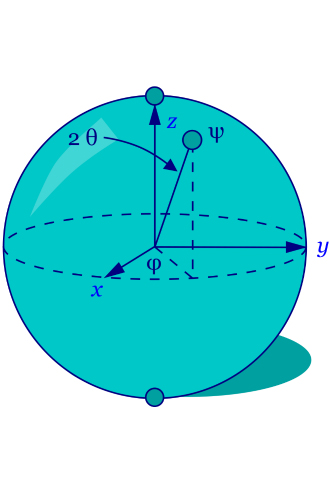Researchers part of prestigious Simons Foundation projects
The two scientists will investigate some of the biggest mysteries in math and physics.
 wikipedia
wikipediaA representation of a qubit, a fundamental measurement of quantum information.
Wrap your brain around this:
Do black holes have interiors? Does the universe exist outside our horizon?
A Brandeis University mathematician and physicist are members of a select consortium of scientists from around the world working on answering fundamental questions like these with millions in funding from the New York-based Simons Foundation, which supports cutting-edge math and science.
Matthew Headrick, associate professor of physics, is among 16 academics investigating the connection between quantum mechanics, gravity and information. He will be serving as deputy director of the entire initiative.
Bong H. Lian, a mathematics professor, is working on a separate project focusing on homological mirror symmetry, a mathematical underpinning of string theory.
Headrick and Lian's teams will each receive about $10 million over four years. The competition to receive the awards was fierce, with 82 proposals initially submitted and only these two finally selected last September.
The questions both Headrick and Lian are researching represent some of the biggest and most fundamental issues in their disciplines.
Headrick's project is titled "It from Qubit: Quantum Fields, Gravity and Information." The research focuses on bringing bring together physics and quantum information theory and showing how some fundamental physical phenomena (spacetime, black holes, etc.) emerge from the very nature of quantum information. Fundamental physics and quantum information theory remain distinct disciplines and communities, separated by significant barriers to communication and collaboration. It from Qubit is a large-scale effort by some of the leading researchers in both communities to foster communication, education and collaboration, thereby advancing both fields. The overarching scientific questions motivating the collaboration include:
- Does spacetime emerge from entanglement?
- Do black holes have interiors?
- Does the universe exist outside our horizon?
- What is the information-theoretic structure of quantum field theories?
- Can quantum computers simulate all physical phenomena?
- How does quantum information flow in time?
Lian is a member of the "Simons Collaboration on Homological Mirror Symmetry," which involves nine investigators from eight different institutions in two countries. Mirror symmetry, first discovered by theoretical physicists in late '80s, is a relationship between two very different-looking physical models of nature, a remarkable equivalence or duality between different versions of a particular species of multidimensional space or shape that seem to give rise to the same physics. People have been trying to give a precise and general mathematical description of this mirroring ever since, and in the process have generated a long list of surprising and far-reaching mathematical predictions and conjectures. The so-called Homological Mirror Symmetry Conjecture (HMS) may be thought of as a culmination of these efforts, and Lian was a member of the group that gave a proof of a precursor to HMS in a series of papers in the late '90s.
Categories: Research, Science and Technology





